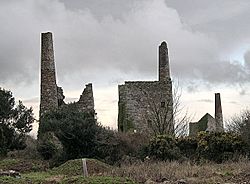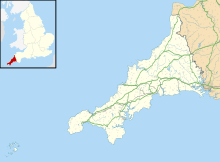Wheal Peevor facts for kids

The engine houses at Wheal Peevor
|
|
| Location | |
|---|---|
| Location | Redruth |
| County | Cornwall |
| Country | England |
| Coordinates | 50°15′12″N 5°13′00″W / 50.253258°N 5.216692°W |
| Production | |
| Products | Copper and Tin |
| History | |
| Opened | 1701 (approx) |
| Closed | 1889 |
Wheal Peevor was an old mine in Cornwall, England. It was located on North Downs, near Redruth. This mine dug up metals like copper and tin. The first permission to mine here was given around 1701. This land belonged to the St Aubyn family.
At first, miners dug for copper close to the surface. But after 1788, copper prices dropped. So, the mine switched to digging for tin ore. Tin was found deeper underground. Wheal Peevor had a big advantage in the late 1700s. It was drained by the Great County Adit, a long tunnel system. This tunnel was about 100 metres deep here. The mine itself was small, only about 12 acres. But it had lots of rich tin veins. Besides tin and copper, miners also dug for pyrite (sometimes called "fool's gold") from 1872 to 1887.
Contents
The Story of Wheal Peevor Mine
Early Days and Reopening
In 1790, Wheal Peevor was part of a larger mine called Great North Downs. It became its own separate mine in 1872. By 1878, people called Wheal Peevor the "surprise of Cornish mining." This was because it was making money from tin. Many other mines in Cornwall were losing money or closing down.
It was also called a "young mine." This meant it had recently reopened. At that time, 156 workers dug underground. By 1880, about 300 miners worked at Wheal Peevor.
Why the Mine Closed
The mine closed in 1889. This was almost 20 years after tin prices fell. New, easy-to-mine tin was found far away. This made tin mining in Cornwall less profitable. Some people tried to explore the site in the 1900s. They hoped to find more minerals.
Attempts to Reopen the Mine
In 1911, a company bought the mine. They wanted to start mining again. Their plan was to dig on the surface first. If that went well, they would pump water out of the mine. After the mine reopened, many old buildings were changed. They made space for bigger, newer machines.
However, only a small amount of tin and tungsten was found. The mine closed again in 1918. Later attempts to reopen it in 1938 and the 1950s also failed.
Wheal Peevor Today
Since 2003, over £800,000 has been spent. This money helped save the old buildings at Wheal Peevor. The site opened to the public in January 2008.
This place is special because it has three engine houses.
- The largest engine had a 72-inch cylinder. It was used to pump water out of the mine.
- The second engine was on the eastern side. It was used for winching (lifting) materials in and out of the mine shaft.
- The third engine had a 32-inch cylinder. It powered 48 "Californian stamps." These were heavy machines used to crush the ore.
Wheal Peevor is now part of the Mineral Tramway Trails project. It is also part of the Cornwall and West Devon Mining Landscape World Heritage Site. This means it's a very important historical place.
Historic Buildings at Wheal Peevor
Several buildings at Wheal Peevor are "Grade II listed." This means they are protected because they are important. They were listed on September 12, 1989. These include:
- The stamps house (where ore was crushed).
- The pump house (where the pumping engine was).
- A house north of the pump engine house.
- The Winding Engine House (where the lifting engine was).
Part of the mine has also been a historic monument since January 15, 1974.


